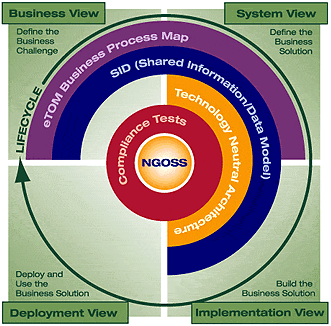
|
|

download & go
|
How NGOSS Compliance Changes the Integration Game (cont'd)
|
Elements of the TeleManagment Forum's NGOSS Resources
|
- Business Process Map: An industry-agreed set of integrated business process descriptions, created with the customer-centric market in mind. These are used for mapping and analyzing operational processes. The Business Process Map itself is documented in the Enhanced Telecom Operations MapTM, or eTOM.
- Information Model: A comprehensive information architecture that includes an industry-defined Shared Information and Data (SID) model. This provides standardized business and systems definitions aimed at achieving business process flow - through.
- Integration Framework: This provides key architectural guidelines and specifications to ensure high levels of flow-through among diverse systems and components.
- Conformance Criteria: These include guidelines and tests to ensure that systems defined and developed utilizing NGOSS specifications will interoperate.
- How-to-Use NGOSS Guidelines: Processes and artefacts are provided that allow developers and integrators to use the toolset to develop NGOSS-based solutions using a standard methodology and lifecycle approach.
|
Each element of NGOSS aligns with particular phases in the OSS/BSS definition, design, development and deployment process. The NGOSS tools are designed to be used in tandem with each other to step through development cycles or individually to address particular business or technical challenges.

NGOSS Benefits
NGOSS can benefit all stakeholders in the OSS/BSS value chain. It can reduce operational and development costs, and helps to eliminate what's known as the "integration tax." NGOSS also improves the speed with which solutions can be modified to meet new needs, and thus provides greater flexibility to service providers as they select OSS components.
- Reduced operational costs: Easier software integration enables tighter coupling of business processes and more automation
- Reduced development costs: NGOSS predefines a substantial portion of development, reducing time, effort and thus cost.
- Reduced integration tax: NGOSS' de facto standardization of the process and information models and architectural framework decreases integration complexity, time and cost
- Speed of modification: With NGOSS, business processes and systems are well understood and mapped, interfaces are well defined, and the architecture is designed for flexibility. The risk of making complex changes to tightly integrated systems is thus reduced, and modifications can be made in shorter cycle times.
- Flexibility in software selection: With simplified integration, service providers gain flexibility in software vendor selection and are not limited to one core vendor and its pre-integrated partners.
Getting NGOSS Adopted
The TMForum's 350 member companies have developed NGOSS over the past four years. It is becoming accepted increasingly as a framework upon which the future of OSS will be built. However, this general acceptance will only follow through to widespread adoption if the TMForum can execute on two critical aspects of the program - compliance and direction.
«Prev
Next » |
1 |
2 |
3 |
4 | Subscribe
Send Comment
© 2004, All information contained herein is the sole property of Pipeline Publishing, LLC. Pipeline Publishing LLC reserves all rights and privileges regarding the use of this information. Any unauthorized use, such as copying, modifying, or reprinting, will be prosecuted under the fullest extent under the governing law.
|
 |



